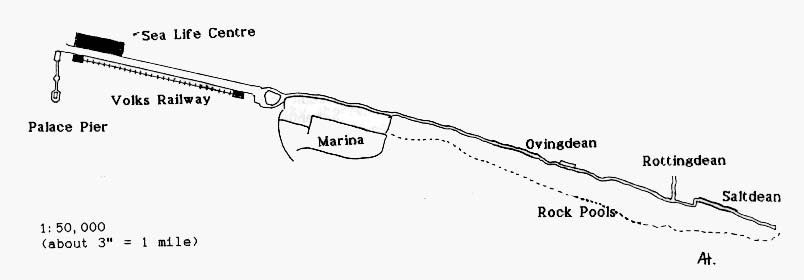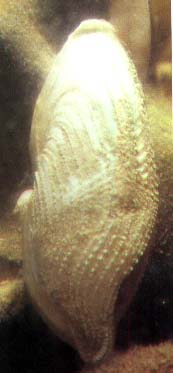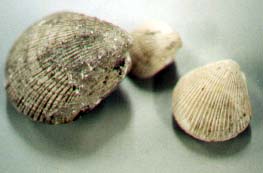
 |
Rockpooling
on the Sussex Shore
by
Andy Horton with Susan Burton, Jenny Byrne, & June Brown
Although informal, this "rockpooling" expedition will go down as the second official field trip organised by the British Marine Life Study Society.
Electric Railway
East of Brighton Marina, the chalk cliffs stretch unbroken for about
seven miles, until they reach the mouth of the River Ouse as it reaches
the sea at the ferry port of Newhaven. A promenade at the foot of the cliffs
runs from the eastern end of Madeira Drive in Brighton to Saltdean, which
is about half way along.
 |
Madeira Drive is the straight coastal racing track, that runs west from the from the Palace Pier and the Aquarium (Brighton Sea Life Centre), with the Volk's Railway running parallel with it to its terminus at Black Rock, which was the best rockpooling area, but has now been built over in concrete. Pools can be reached from the Madeira Drive end, but it involves a walk of nearly a mile past the marina.
A further railway ran along the flat bedrock shore for a short time during the last century. Concrete supports (called Daddy-long-legs) of the ill fated Brighton and Rottingdean Seashore Electric Railway (1896-1901) remain as evidence of the folly of the original idea. The track was, of course, washed away by the winter storms.
Serrated Wrack draped over the Chalk Boulders at Brighton, east of the Marina
Waves still batter at the chalk cliffs, and hurl pebbles over the promenade, so that the route is impassable when the worst weather coincides with high tides. At these times, it is also dangerous. Several people that been dragged out to sea and drowned.
Chalk and Piddocks
 For
rockpoolers familiar with the aesthetic rocky shores of the west coast
of England and Wales, the view from the top of cliffs may not look promising.
It is only when you venture down below the shingle line, is the richness
and diversity of life revealed. Erosion and the effect of the frosts has
resulted in rocks being strewn over the flattish chalk rock beach. Fresh
water freezes and expands, causing the chalk to crack open and break apart.
For
rockpoolers familiar with the aesthetic rocky shores of the west coast
of England and Wales, the view from the top of cliffs may not look promising.
It is only when you venture down below the shingle line, is the richness
and diversity of life revealed. Erosion and the effect of the frosts has
resulted in rocks being strewn over the flattish chalk rock beach. Fresh
water freezes and expands, causing the chalk to crack open and break apart.
Piddocks
in Chalk Rocks from Brighton Beach
The
Snakelocks
Anemone, Anemonia viridis, is at the edge of its distribution
range at Brighton and occurrences on the shore are extremely rare (one
discovered in 100 visits).
The Piddock, Pholas dactylus, is a bivalve mollusc that drills right into the chalk rock, where it spends its life. Chalk boulders and smaller rocks on the beach are warrened with piddock burrows, the living animal having departed, providing hiding places for small fish, crabs, and sea anemones.
Tides and Access
Low spring tides, when the tide goes out the furthest occur at approximately the same time of the day in every year in different parts of the country. The tidal variation of the lowest tides (measured at Shoreham-by-Sea) is a height of 6.6 metres. High tide occurs just before midday on the springs, and low tide about 6 hours 12 minutes later, will occur in the early evening; or the early morning if you are a dawn riser.
We chose the evening low tide to arrive late in the afternoon, to follow the receding tide. Access to the shore is possible at both Ovingdean (just east of Roedean, by St.Dunstan's) by walking through a tunnel under the coast road, or at Rottingdean.
From the well pubbed and attractive village of Rottingdean, a
concrete slope led us down to the promenade. The rocky shore immediately
in front of you is still covered by the sea, but to either side, the tide
is ebbing rapidly to reveal rocks and weed for miles in either direction.
Old clothes are obligatory. Plimsolls are sometimes better than
gum boots, because of the better grip they afford on slippery rocks.
Permanent Fauna and Ecology
Temperature in the surface waters of the English Channel is recorded at 170C off Sussex, but measured inshore the temperature often reaches 190C in July and August. In the tidal pools on the upper shore, the rays of the sun may heat the small amounts of water up to 240C and above. The sea is more turbid that the clear oceanic waters off Cornwall. This is partly because chalk is a soft rock, and it crumbles easily. Plankton is different too; the coastal type - there are several indicator species. Fauna is consequently not so varied, but because of the warmer water, more species will be found than on the eastern North Sea coasts.
It is difficult to decide which section of the beach is the best to explore. One characteristic of this type of shore is the predominance of slippery weeds; in this case, principally the Serrated Wrack, Fucus serratus, draped over the edge of chalk boulders, but appearing from the promenade as a continuous mat covering hundreds of metres. The small Flat Winkle, Littorina littoralis, lives amongst the fronds. It is found in a variety of colours, including yellow, green, and red.
Zoning demarcation on this flat shore is not clearly defined. Spiral Wrack, Fucus spiralis, occurs on the topshore, the seaweed growing where the promenade wall adjoins the high tide mark. Otherwise, most of the visible shore is mid-tide level fauna.
Actinia equina
It is only on low springs that the lower shore animals and algae are revealed. For this reason, it is best to choose the part of the shore where the tide has receded the most. Concrete groynes lead down to the sea. It is possible to follow them down, walking along available ledges; at the same observing the few animals that can live in these exposed conditions, notably the Limpet, Patella vulgata, clamped tightly to rocks and concrete. Also two species of Acorn Barnacles, mostly Balanus balanoides, which can raze a nasty graze to the careless. In crannies, the first Beadlet Anemones, Actinia equina, can be spotted, appearing as jelly-like blobs in red and green. In sheltered locations, Periwinkles, Littorea littoralis, congregate. This edible mollusc is collected and numbers have been reduced appreciably.
Hoary Stock, Matthiola incana
Hoary Stock looks a little like a wallflower growing on the chalk cliffs and beside roads, where it could easily be mistaken for a garden escape. The flowers, which are generally purple, are sweet scented and appear from May to August. It is only found in Britain on the Isle of Wight and on the chalk cliffs and adjacent grasslands at Brighton, East Sussex.
Piddock, Pholas dactylus
The Piddock, Pholas dactylus, is a bivalve mollusc that drills right into the submerged chalk rock, where it spends its life. Chalk boulders and smaller rocks on the beach are warrened with piddock burrows, the living animal having departed, providing hiding places for small fish, crabs, and sea anemones.
 Photograph
by Evan Jones
Photograph
by Evan Jones
The burrowing prawn known as Axius stirhynchus, lives in burrows offshore. The numbers of this crustacean, which is uncommon in British seas, are unknown.
Fossils
 Fossil bivalve Spondylus spinosa
Fossil bivalve Spondylus spinosa
This superficially cockle-like bivalve is occasionally found in fossil form on the chalk wave-cut platform.
The fossil bivalve (order: Pterioida,
Family: Spondylidae) is found in Lower Cretaceous
rocks, especially the chalk of south-east England.
(Santonian Micraster Chalk community).
The illustrated fossils are from the Marlipins Museum.
On the pebbles, the fossil heart urchin Echinocorys scutatus (pic) has been found.
SUPERABUNDANT = 10,000 +
ABUNDANT 1000- 10,000
VERY COMMON = 500-1000
COMMON 100-500
VERY FREQUENT = 50-100
FREQUENT 10 - 50
OCCASIONAL 2-10
RARE = ONLY 1
5 January 1999: We may revert to original
system as if two systems are in use, it can be confusing.
5 October 2000: Amended; there is an overlap
to avoid confusion if two systems are in operation.

Birds of Ovingdean
Rockpooling Page
Seashore Aquariologist
Saltdean
in the Good Beach Guide
Sussex Dolphins
|
|
|
|
|
News 2018 |
Membership Form |
|
|
|